|
#1
| |||
| |||
|
I am doing B.Sc from the Bangalore. and here I am searching for the B.Sc maths syllabus. Can you provide me the syllabus and model question paper? And also tell me that can I download the syllabus freely and question paper?
|
|
#2
| |||
| |||
|
Here I am forwarding you the B.Sc Maths Syllabus of Bangalore .it also contain model paper which will help you in preparation of your exam
__________________ https://t.me/pump_upp |
|
#3
| |||
| |||
|
Hi, I am Sumathi student of University of Arizona (USA). I am desperately looking for BSc annual scheme (2003 to 2006) Bangalore University syllabus for Physics, Chemistry, and Mathematics. I would be greatful to you, if you could please help me to find a link (Pdf copy. Thank you Sumathi (0015208783509) sumathimallikarjun@gmail.com sumathi@email.arizona.edu |
|
#6
| |||
| |||
|
Here I am providing you the B.Sc Maths Syllabus of Bangalore .it also contain model paper which will help you in preparation of your exam B.Sc. Statistics Model Question Paper First Semester: Theory Paper STP1: Basic Statistics and Probability Instructions: 1.Answer Section A, Section B and any four question from Section C 2. Answer sub-divisions from Section A in the first two pages only. SECTION ‘A’ Answer any Six Sub-division: (2 Marks each) 1. a. Distinguish between (i) Nomial and ordinal data (ii) Simple and weighted averages b. State the propertics of arithmet- Mean c. What is curve Fitting? d. If two regression lines are 3x+xy-26=0 and 6x+y-31=0 find correlation coefficient. e. Prove the Laspeyrc’s price index number is the weighted A.M. of the price relatives. f. What is time series? State the models used in time series analysis. g. Define conditional probability. h.Given P (A)=0.3 P(A UB)=0.6 P(B)=p find p if (i) A & B are mutually exclusive (ii) A &B are independent. SECTION ‘B’ Answer any three Sub-division: (4 Marks each) 2. a. What are partition values? How are they determined graphically? Explain b. What is skew ness? Describe its various measures. c. What is scatter diagram? Interpret various types of correlation coefficient using scatter diagram. d.Explain the various steps involved in the construction of consumer price index numbers e. Define “sample space” and “event”. Write the sample space of the random experiment of throwing two dice. SECTION ‘C’ Answer any four Sub-division: (9 Marks each) 3. a) Define weighted Arithmetic mean, Find the weighted arithmetic mean of first ‘n’ natural numbers, with weights being corresponding numbers. b) Derive the formula for mode in case of a continuous frequency distribution (4+5) 4. a) Define mean deviation and prove that is least when it is measured from the median b) Define Kurtosis and prove that moment co-efficient of Kurtosis is independent of change of origin and scale. (5+4) 5. a) Describe the principle of least squares in curve fitting. Obtain the normal equations-for fitting curve of the type y=a+bx b) Derive the expression for spearman’s Rank correlation co -efficient. (4+5) 6. a) Explain the method of obtaining seasonal indices by the method of ratio to moving average. b) Explain time and factor reversal tests and show that Fisher’s index number satisfies both the tests. (4+5) 7. a) Define mutually exclusive events. Two cards are drawn from a pack of playing cards randomly. Find the probability of getting i) Two kings, (ii) One spade and one clcb. iii) An ace and a knave. b) If A and B are two events then prove that i) P (AUB)= P (A)+P (B)-P (AUB) (4+5) 8. a) Whate are independent events? Obtain the total number of conditions required for mutual independence of ‘n’ events. (4+5) b) State Bayes theorem. (4+5) Three urns contain 2 white and 3 black balls. 3 White & 2 black balls and 4 white and I black ball respectively. One ball is drawn from an urn chosen at random and it was found to be white. Find the probability that it was drawn from the first urn. Second Semester B.Sc. Statistics Examination Model Question Paper STP2: Probability Distributions and Multiple Regression Instructions: 1.Answer Section A, Section B and any four question from Section C 2. Answer sub-divisions from Section A in the first two pages only. SECTION ‘A’ Answer any Six Sub-division: (2 Marks each) 1 a. Define i) Distribution function ii) Probability Density function b. Suppose that X has the p.d.f. f(x)=2x, 0<x< 1 find the p.d.f of Y=3X+1 c. State the p.m.f. of a negative binomial distribution. Show that geometric distribution is a particular case of negative binomial distribution. d. State the ‘Lack of Memory’ property of exponential distribution. e. State the properties of a Normal distribution f. If X and Y are independent random variables, show that they are uncorrelated. Comment on the coverse. g. Distinguish between multiple correlation and partial correlation h. Define and explain how can one interprets the coefficient of multiple determination.? SECTION ‘B’ Answer any three Sub-division: (4 Marks each) 2. a. Define moment generating function of a.r.v State its properties and prove any one of them. b. What is convergence in distribution? State the conditions for the convergences of (i) Binomial distribution to normal distribution and (ii) Hyper geometric distribution to Binomial distribution. c. State and prove additive property of Gamma variates. d. Define: i) Joint and marginal probability density functions ii) Conditional expectation e. i) State the properties of least squares residuls. ii) Define residual variance in a trivariate set up. SECTION ‘C’ Answer any four Sub-division: (9 Marks each) 3. a) Suppose X is a Continuous random variable with p.d.f: f(x)=c (1-x2) for 0 <x< 1. Determine c and find the distribution function. b) Find the first four moments about the mean of the distribution having the p.d.f f(x)=f(x)=a/2; 0<x<a (4+5) 4 a) Obtain the recurrence relation for central moment of a binomial distribution b) If x is a Poisson variate and P(O)=P(1)=c, then show that c=1/e (6+3) 5 a) Find m.g.f. of negative binomial distribution b) Find mean and variance of beta distribution of second kind (3+6) 6. a) Show that a linear combination of independent normal variates is a normal variate and hence establish the additive property. b) Define Cauchy distribution and show that it is symmetric. (6+3) 7. a) State and prove addition theorem expectation b) If the joint p.m.f of X and Y is p (x,y)= xy/9 x =1,2 and y=1,2, obtain the marginal p.m.f s and show that: X and Y are independent (5+4) 8.a) Define multiple correlation coefficient and show that in the usual notation R21.23=1- b) If r12=r13=r23=r, prove That r 12.3=r/1+r (7+2) B.Sc. Statistics Model Question Paper Third semester: Theory Paper STP3: Sampling Distributions and Estimation Instructions: 1.Answer Section A, Section B and any four question from Section C 2. Answer sub-divisions from Section A in the first two pages only. SECTION ‘A’ Answer any Six Sub-division: (2x6=12) 1.a) What is meant by a “random sample”? b) If X has a chi-square distribution with 10 degrees of freedom find its mean and variance. c) State the inter-relationship between, X2 t and F distributions. d) If x is the sample mean of a random sample from N (m, 2) show that xnm in probability. e) Determine the relative efficiency of sample mean over sample median for N (m,2)distribution. f) Define i| Mean square error, ii|Fisher’s information function g) State Cramer-Rao, Inequality. h) Given a random sample of size n from Poisson population find MLE of P [X=0]. Where X follows Poisson distribution with parameter SECTION ‘B’ Answer any Three Sub-division: (4x3=12) 2. a) i) State the Features of F-distribution. ii) Mention any two applications of t-distribution b) State Levy Linderberg Central limit theorem and using it find the large sample distribution of the sample mean X from a sampling from Poisson distribution. c) If E (Tn)→0 and V (Tn) →0 as n→oo then show that Tn is consistent for 0. d) In a random sampling from a population with P.D.F: f(x, 0)=0x0-1, 0<x<1, 0>0 show IT xi is sufficient for 0 e) Obtain large sample(1-a) 100% confidence interval for the mean of a normal population when variance is known. SECTION ‘C’ Answer any four Questions: (9x4=36) 3. a) State and prove additive property of K independent chi-square varieties b) Obtain mean and variance of t-distributions. [4+5] 4. a) Obtain the distribution of reciprocal of F-variate b) In random sampling from the population N (u, 2), show that X and S2 are independent [4+5] 5. a) State Chebyshev’s inequality. Let r.v. X have the pdf: f(x)=1 2 3- 3 <x<3, Find the actual probability Pux-uz 1.5 and compare it with the upper bound obtained by Chebyshev’s inequality. b) Show that a sequence of i.i d. random variables satisfies the W.L.L.N. [5+4] 6. a) If T is an unbiased estimator of 0. then show that T2 is also a consistent estimator of 02 b) Obtain minimum variance bound estimator for u in a sampling from the population N(m2) where is known. [5+4] 7. a) Define a “M.L.E” and State some large sample properties of a M.L.E b) Obtain moment estimators of the parameters of uniform distribution U(a,b). [4+5] 8. a) Obtain M.L.E. of 0 in exponential distribution with mean 1/0 based on random sample of size n. b) Explain the pivotal quantity method of finding confidence interval for a parameter and obtain (1-a) 100% confidence interval for the ratio of two variances of normal populations. B.Sc. Statistics Model Question Paper Fourth semester: Theory Paper STP4: Sampling Distributions and Estimation Instructions: 1.Answer Section A, Section B and any four question from Section C 2. Answer sub-divisions from Section A in the first two pages only. SECTION ‘A’ Answer any Six Sub-division: (2x6=12) 1. a) Distinguish between level of significance and size of a test. b) State Neyman-Pearson fundamental lemma c) A test function based on a sample (x1, x2)for testing certain null hypothesis is given by (x1 x2)=1, if x1+x2<4/ What is your decision if the sample if [i] (x1=x2. x2=5) and [ii] (x1=3. x2=1)? d) define a Uniformly Most Powerful [UMP] test e) State properties of likelihood ratio tests f) State the assumptions required for appling t-test g) Describe Sequential Probability Ratio Test [SPRT] h] State some of the advantages and disadvantages of non-parametric tests. SECTION-B Answer any three Questions: (4x3=12) 2. a) If C={(x:x<)} is the critical region of a test based on single observations X for testing H:0=2. against K: 0=1 being the parameter of f[x,0]=0 exp (-0x), 0<x,, compute size and power of the test. b) State the MLR property. Examine whether the family of Poisson distributions with mean 0< has this property c) Describe ;chi-square test of goodness of fit. d) In an SPRT, describe how stopping bounds are obtained using its strength e) Define a run with examples. Describe run test for randomness of a sample. SECTION -C Answer any Four Questions : (9x4=36) 3. a) Explain [i] simple and composite hypotheses, [ii] Power of a test b) Construct the most powerful [MP] test of size u for H:µ= µo. Against K: µ= µ1. based on a random sample of size n form N(µ2)-distribution With 2 known. [4+5] 4. a) Describe likelihood ratio test b) Given a random sample of size n from N (µ2), drive the likelihood ratio test for testing H: µ= µo against K: µ= µo, when 2 is unknown. [3+6] 5. a) Describe a large sample test for the equality of means of two normal Distributions with unknown variances. b) Describe chi-square for testing H: 2=2 against. One sided and two-sided alternatives. 2 being the variance of a normal distribution. [4+5] 6. a) Explain F-test for testing the equality of variances of two normal distributions. b) Explain Fisher’s Z-transformation. Describe a test for H: p-p Where p is the population correlation coefficient. [4+5] 7. Construct SPRT for testing H  =p against K: p=p1 p1>p0, being the Parameter the =p against K: p=p1 p1>p0, being the Parameter theBernou’I distribution. Give approximate expressions for the O.C. and A.S.N. functions. [9] 8. a] Describe sign test for paired observations b] Describe Mann-Whitney-Wilcox on test. B.Sc. Statistics Model Question Paper Fifth Semester: Theory Paper STP5: Sampling Theory And Applications Instructions: Answer five subdivisions from section A and five question from Section B SECTION ‘A’ 1. Answer any FIVE Sub-division: (5x3=15) a. Distinguish between SRSWOR and SRSWR and compare their efficiencies b. Prove that the probability of selecting a specified unit of the population at any given draw is equal to the probability of its being selected at the first draw. c. Prove that the sample proportion is an unbiased estimator of population proportion. d. What is Stratified Random Sampling? Mention its advantages. e. Distinguish between linear systematic sampling and circular systematic sampling f. Explain the factors causing Non-sampling errors. g. Distinguish between plot sampling and transect sampling. SECTION-B Answer any FIVE questions (5x9=45) 2. a. Explain the use of random number tables in the selection of random sample. b. Describe the advantages of sampling over complete enumeration. (4+5) 3. What is Simple Random Sampling? Derive the expression for the variance of sample mean under SRSWOR and Set up the Confidence Interval for population mean and total. [9] 4. a. With usual notations show that V(A)= N2 (N-m) PQ n (n-1) b. Obtain an expression for sample size while estimating population mean. (4+5) 5. Suggest an unbiased estimator of the population mean in case of stratified random sampling. Derive its variance and deduce it under proportional and Neyman allocations (9) 6. a. In Stratified random sampling , ignoring f.p.c prove that variance of the estimated mean under proportional allocation is not less than the variance of the estimated mean under neyman allocation. b. Prove that the mean of a systematic sample is more precise than the mean of a simple random sample iff S2wsy>S2 (5+4) 7. Describe systematic sampling and obtain an expression for variance of mean under systematic sampling in terms of intra class correlation co-efficient and compare the efficiency of this estimator with SRSWOR. (9) 8. a. State the principal steps involved in conducting a sample survey. b. Explain the working of N.S.S.O. c. Define the ecological measurements [i] density, [ii] frequency, [iii] Biomass (3+3+3) B.Sc. Statistics Model Question Paper Fifth Semester: Theory Paper STP6.1: Statistical Methods For Quality Management Instructions: Answer five subdivisions from section A and five question from Section B SECTION ‘A’ 1. Answer any FIVE Sub-division: (5x3=15) a) Explain the meaning of ‘quality’ and ‘quality assurance’. b) Mention the various types of ‘quality costs’. c) Distinguish between action limits and warning limits and state their uses in a control chart. d) Define process capability ratio and indicate its use. e) Obtain the control limits for C-chart. f) Define the terms AQL, AOQL and LTPD. g) Define the following terms i] Reliability of a component ii] Hazard rate iii] I.F.R. distribution SECTION-B Answer any FIVE questions (5x9=45) 2. a) What is statistical quality control? Discuss its need and utility in industry b) Distinguish between chance and assignable causes. What are the advantages of statistically controlled process? (5+4) 3. a) Derive the control limits for X-S chart. When process standards are unknown. b) Discuss the criteria for detecting the lack of control in a control chart. (5+4) 4. a) What is rational sub grouping? Explain the methods for this purpose b) Describe the construction and interpretation of sloping control chart for mean. (5+4) 5. a) Explain the basis and construction of p-chart. Give instances of its applicability. b) Define OC and ARL functions of a control chart. Derive their expressions for X-chart. (4+5) 6. a) What are acceptance sampling plans? And explain the terms i] Indifference quality and ii] Acceptance number b) Describe double sampling plan c) Explain the method of designing a SSP such that OC curve will pass through two designated points. (3+3+3) 7. a) Distinguish between ASN and ATI b) Obtain an expression for consumer’s risk, producer’s risk and AOQ function for double sampling plan (2+7) 8. a) Show that failure rate is constant if the time of a component has exponential distribution. b) If R1 and R2 are the reliabilities of two components functioning independently and connected in series, then prove that the reliability of the system is given by Rs=R1, R2 c) Write the block diagram of a system whose structure function is (x)=x1 x2 Max (x3, x4) and find the reliability of the system. (3+3+3) B.Sc. Statistics Model Question Paper Sixth Semester: Theory Paper-I STP7: Experimental Designs And Demography Duration: 3 Hrs. Max Marks: 60 Instructions: Answer five subdivisions from section A and five question from Section B SECTION ‘A’ 1. Answer any FIVE Sub-division: (5x3=15) a) State Gauss-Markov theorem. b) Explain randamisation with reference to CRD and give its layout. c) What is a contrast? When are two contrasts said to be orthogonal? d) Give a layout of RBD with three replications where in AB, BC and AC are confounded. e) Distinguish between crude and standardized death rates. f) Explain the terms ‘Fertility’ and ‘fecundity’ And ‘Morbidity’ g) Mention the uses of life tables. SECTION -B Answer any FIVE Sub-division: (5x9=45) 2. a) For the linear statistical model. Yij= µ+ai+eij j=1,2…….n, i=1, 2…..k and Show that mean error sum of square is an unbiased estimator of the population variance. b), Explain the role of ‘critical difference’ in Analysis of variance (5+4) 3. Describe the analysis of a Two-way classified data with single observation per cell. (9) 4. a) Explain the basic principles of Design of experiments. b) Obtain the relative efficiency of RBD over CRD. (5+4) 5. a). Obtain the least square estimates of the parameters of a fixed effect model of Latin Square Design. b) Derive an expression for estimating a single missing value in a LSD. (5+4) 6. a) Define ‘Main’ and ‘Interaction effects’ Derive expressions for the effects and AB in 22 factorial experiment. b) Explain the analysis of 22 factorial experiment in RBD with ‘r’ replications. (4+5) 7. a) Explain the different methods of collecting vital statistics. b) Define Gross reproduction rate and net reproduction rate show that GRR>NRR. (3+6) 8. a) Explain the different components of a life table. b) With usual notations show that: qx=2mx/2+mx (4+5) B.Sc. Statistics Model Question Paper Sixth Semester: Theory Paper STP8.1: Operations Research And Programming In ‘C’ Duration: 3 Hrs. Max Marks: 60 Instructions: Answer five subdivisions from section A and five question from Section B SECTION-A 1. Answer any FIVE Sub-division: (5x3=15) a. Explain the following models (i) Analog (ii) Iconic (iii) Symbolic b. Explain the Laplace criterion for arriving at a decision under uncertainty. c. Define a rectangular game and write the condition for the existence of a saddle point. d. Define the following (i) Demand (ii) Lead time (iii) Shortage cost. e. Describe the queuing model (M/M/I: FIFO/N/) f. Explain the following with reference to a PERT problem: (i) Total float (ii) Free float (iii) Independent float g. Describe the method of Inverse transformation for generating observations from exponential distributions. SECTION-B Answer any FIVE Sub-division: (5x9=45) 2. a. Obtain all basic solutions for the following system of equations and classify them on the basis of feasibility and degeneracy. X1+2x2+3x3=12 3X1+2X3+X3=12 b. Outline the steps under simplex algorithm for solving a Linear Programming problem. (3+6) 3. a. Explain EMV criterion of arriving at a decision under uncertainty. How do you calculate expected value of perfect information? b. For the (2x2) rectangular game without saddle point. (i) Obtain the pay-off function (ii) Determine the optimum mixed strategies for both the players. (iii) What will be the value of the game? (4+5) 4. a. Define inventory and mention the advantages of maintaining inventory. b. Obtain an expression for Optimum Quantity to be ordered under EOQ model when shortages are not permitted. (3+6) 5. a. Explain the following with respect to a queuing system (i) Balking and Reneging (ii) Series and parallel service channels. b. Derive the expression for Average Queue Length [Ls] in (M/M/1: FIFO/N/o) queuing system. (4+5) 6.a. Construct the network for the following project. Activity: (1,2) (1,3) (1,4) (2,5) (2,3) (3,5) (4,5) Duration: 5,14 8 6 3 5 4 b. Describe the method of estimating using Monte Carlo method (4+5) 7. a. Define the basic data types in ‘C’ with examples b. List out the loop statements available in C, Explain any two of them with examples. (4+5) 8. a. Bring out eh difference between the conditional operation and if else statements. Wirte the output of the following program. Main() {Intx=5; swith (5-x) “case 0:x=x+5 case 4: x++; break; case 10: x=10; printf (%d” x); b. Explain the rules for defining a function in C. Also explain the use continue statement in a function. 1. Answer any fifteen of the following: (2x15=30) 1) Write the negation of V x [P (x) → q(x)]. 2) Find T [P (x)], if P(x): x2-3x+2=0, the replacement set is z. 3) Define an equivalence relation. 4) If f: Q→Q is defined by f(x)=3x+1, Vx€Q, then show that f is onto. 5) Find the nth derivative of Cx/2, Sin 2x. 6) Find the nth derivative of Sin3 2x. 7) If z=xy, then find ∂2z/∂x ∂y 8) If y2=4ax, find dy/dx using partial differentiation. 9) If u=x3-2x2y+3xy2+y3, prove that x ∂u/∂x+y ∂u/∂y=3u. 10 If u=2x-3y∞, v=5x+4y, show that ∂ (u,v)/ ∂ (x,y)=23. 11) Evaluate ∫dx/ (1+x2)7/2 12) Evaluate ∫π2Sin 4x cos3x dx. 13) Find the direction cosines of the joining (2,-3, 6) and (3, -1,-6). 14) Show that the line x-1/-1= y+1/1=z/1 lies on the plane x-y+2z=2. 15) Find the equation of a plane passing through (2,3, 4) and perpendicular to the vector ^i+^j+^k. 16) Express the equation of the plane 3x-y+6z=9 in the normal form. 17) Find the distance between the parallel planes 2x-y+3z=-4 and 4x-2y+6z-6=0. 18) Find the angle between the plane 2x+y+2z=5 and the line x-1/2= y+1/-1 = z-1/2. 19) Find the equation of a sphere concentric with the sphere 2x2 +2y2+2z2-4x+6y-8z+1=0, passing through (2,1,-3) 20) Find the equation of cone whose vertex is at the origin, the axis is x/2=y/1=z/3 and the semi vertical angle is 30˚. II. Answer any two of the following: (5x2=10) 1) With the usual notation, prove that: T[P (x) → q(x)]= [T[P (x)] UT [ q(x)]. 2) a) Symbolise and negate ‘Some integers are perfect squares or all integers are rational numbers’ b) Give the direct proof of the statement: ‘If x+y is even, then x any y are both odd or both even’ where x and y are integers. 3) Prove that any partition P of a non empty set A determines an equivalence relation. On A. 4) If f:R→R; g:R →R are defined by f(x)=2x+1 and g(x)=5-3x, verify (gof)-1=f-1 o g-1. III. Answer any three of the following: (5x3=15) 1) Find the nth derivative of 3x+2/ x3+x2 2) If y=cos(m sin-1 x), show that yn+1 4n2-m2 7n = 4n+2 at x=0. 3) State and prove Leibniz’s theorem for nth derivative of product of two functions. 4) If u= x/y+z + y/ z+x + z/x+y, show that x ∂u/∂x+ y ∂u/∂y+z ∂u/∂z=0. 5) If u=2xy, v=x2-y2, x=r cos ø, y=r sin ø. prove that ∂ (u, v)/ ∂ (r, 0) = -4r3. IV. Answer any two of the following: (5x2=10) 1) Obtain the reduction formula for ﺈπ/2Sinm x cosn x dx. 2) Using Leibnitz’s rule for differentiations under the integral sign, evaluate ∫xa-1 logx dx, where a is a parameter. 3) Evaluate ∫√2x3 dx √x2-1 V. Answer any three of the following: (5x3=15) 1. Find the volume of the tetrahedron formed by the pints. (1, 1, 3), (4, 3, 2,) (5, 2, 7) and (6, 4, 8). 2. If a line makes angles ﻤ βﻼu,B,Y and __ with four diagonals of a cube, show that cos2 u+cos2 β+cos2 ﻼ+cos2 S=4/3. 3. Prove that the lines (x-5)/4 = (y-7)/4 = (z-3)/-5 and (x-8)/7 = (y-4)/1 = (z-5)/3 are coplanar. Find the equation of the plane containing them. 4. Find the length and foot of the perpendicular drawn from (1, 1, 2) to the plane 2x- 2y+4z+5=0. 5. Find the shortest distance between the lines (x-8)/3 = (y+ه)/-16 = (z-10)/7 and (x-15)/3 = (y-29)/8 = (z-5)/-5. VI. Answer any three of the following: (5x2=10) 1. Find the equation of a sphere passing through the points (1, 0, 0), (0, 1, 0), (0, 0, 1), and (2,-1, 1). Find its centre and radius. 2. Derive the equation of a right circular cone in the standard form x2+y2=z2 tan2 ά. 3. Find the equation of right circular cylinder of radius 3 units, whose axis passes through the point (1, 2, 3) and has direction rations (2,-3, 6). SECOND SEMESTER B.Sc./B.A. EXAMINATION. MATHEMATICS (PAPER-II) Instructions: 1. Answer all questions. 2. Answers should be written completely either in English or in Kannada. (2x15=30) I. Answer any fifteen of the following: 1. If 0 is an eigen value of square matrix A, then prove that A is singular. 2. For what value of x is the rank of the matrix a equal to 3 given. A= 2 4 2 3 1 2 1 0 x 3. 3. Find the value of k such that the following system of equations has non-trivial solutions.(k-1)x+ (3k+1)y+2kz=0 (k-1)x+ (4k+2)y+(k+3_z=0 2x+(3k+1)y+3 (k-1)z=0. 4. Find the eigen value of the metric A= a h g 0 b 0 0 c c 5. For the matrix A= 3 1 -1 2 the characteristic equation is ג2-ג -5=0. Using it, find A-1. 6. For an equiangular spiral r=a eөcota show that the tangent at every point is inclined at a constant angle with the radius vector. 7. Find the pedal equation of the carver r=aө. 8. Show that for the curve rө=a the polar sub tangent is a constant. 9. In the curve pan=rn+1, show that the radius of curvature varies in-versely as the (n-1)th power of the radius vector. 10. Show that the origin is conjugate point of the curve x2+3y2+x3y=0. 11. Find the envelope of the family of lines y=mx+a/m, where m is a parameter. 12. Find the asymptotes (if any) of the curve x3y2+x2 y3=x3+y3 parallel to the y-axis. 13. Prove that y=ex is every where concave upwards. 14. Find the length of the arc of the semi-cubical parbola ay2=x3 from the vertex to the point (a,a) 15. Find the whole area of the circle r=2a cos ө. 16. Solve: dy/dx+y/x=1/x 17. Solve: dy/dx+y=sin x, 18. Find the integrating factor of the equation x dy-y dx+2x3 dx=0. 19. Solve: p2+p(x+y)+xy=0 where p=dy/dx. 20. Find the singular solution of y=xp+p2. II. Answer any three questions: (3x5=15) 1. Find the rank of the matrix a by reducing to the normal form given:A= 1 -1 -2 -4 2 3 -1 -1 3 1 3 -2 3 -3 4 6 3 0 -7 2. If A= 2 -3 4 determine two non-singular matrices P and Q such that PAQ=I, Hence find A-1. 0 -1 1 3. For what values of λ and μ the equations:x+y+z=6 x+6y+3z=10 x+2y+ λz= μ have (1) no solution (2) a unique solution (3) infinite number of solutions. 4. Find the eigen values and eigen sectors of the matrix: A= 1 2 3 0 -4 2 0 0 7 5. State and prove the Cayley-Hamilton theorem. III. Answer any three questions: (2x5=10) 1. Find the angle of intersection of the parabolas r= a/1+cos0 and r=b/1-cos0 2. Show that the p-r equation of the curves x=a cos3 0 and y=a sin3 0 is r2=a2-3p2. 3. For the curve x=x(t)y=y(t) show that the radius of curvature. P=[x2+y2]3/2 xÿ-ýx 4. Prove that the evolute of the ellipse x2 + y2 = 1 is (ax)2/3+(by)2/3= (a2-b2)2/3 a2 b2 IV. Answer any three questions: (2x5=10) 1. Find the points of inflexion on the curve x=10g[y/x) 2. Determine the position and nature of the double points on the curve u\y(y-6)=x2(x-2)3-9. 3. Find all the asymptotes of the curve 4x2(y-x)+y (y-2) (x-y)=4x+4y-7. 4. Trace the curve y2(a-x)=x2(a=x) V. Answer any three questions: (2x5=10) 1. Find the perimeter of the asteroid x2/3+y2/3=a2/3. 2. Find the surface area generated by revolving an arch of the cycloid x=a(0-sin 0) y=a (1- cos 0) a bout the x-axis. 3. Find the volume of the solid generated by revolving the cardioid r=a (1+cos 0) about the initial line. VI. Answer any three questions: (3x5=15) 1. Solve: dy/dx +y cos x=yn sin 2x 2. Solve: dy/dx= x+2y-3/ 2x+y-3. 3. Solve: 2y dx+(2x log x-xy) dy=0. 4. Show that the family of parabolas y2=4a (x+a) are self orthogomal. Remaining Question and syllabus are in the attachment please click on it.......
__________________ Answered By StudyChaCha Member |
|
#8
| |||
| |||
|
As you are looking to download the syllabus of B.Sc Physics of Bangalore University, so here I am giving the following syllabus to you: Bangalore University B.Sc Physics Syllabus Semester 1 Mechanics, Properties of Matter, Relativity and Electricity Practicals Mathematical Physics I Semester 2 Thermal Physics and Oscillations Practicals Mathematical Physics II Computational Physics (Practicals) Semester 3 Electrodynamics I and Quantum Mechanics I Practicals Thermodynamics and Statistical Physics Semester 4 Electronics I and Optics Practicals Mathematical Physics III and Quantum Mechanics II Semester 5 Nuclear Physics I and Solid State Physics I Practicals Electrodynamics II and Electronics II Semester 6 Atomic Physics, Particle Physics & Cosmic Rays Practicals Astrophysics, Cosmology and Classical Mechanics Solid State Physics II Nuclear Physics II Practicals Project Work Bangalore University B.Sc Physics Syllabus 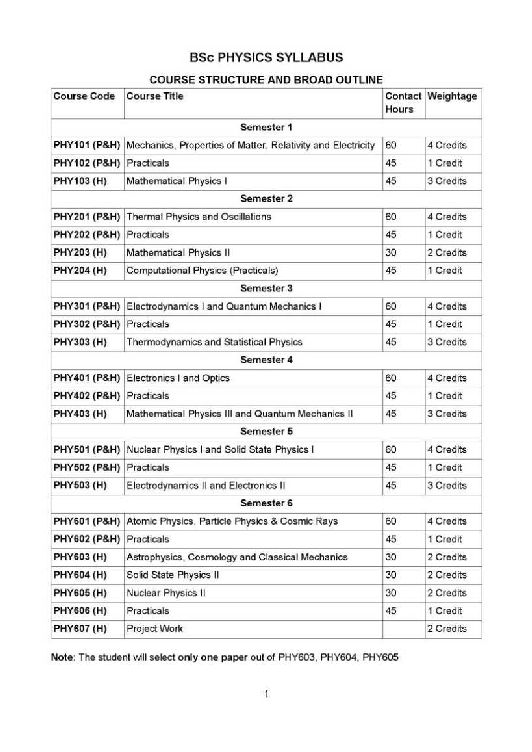 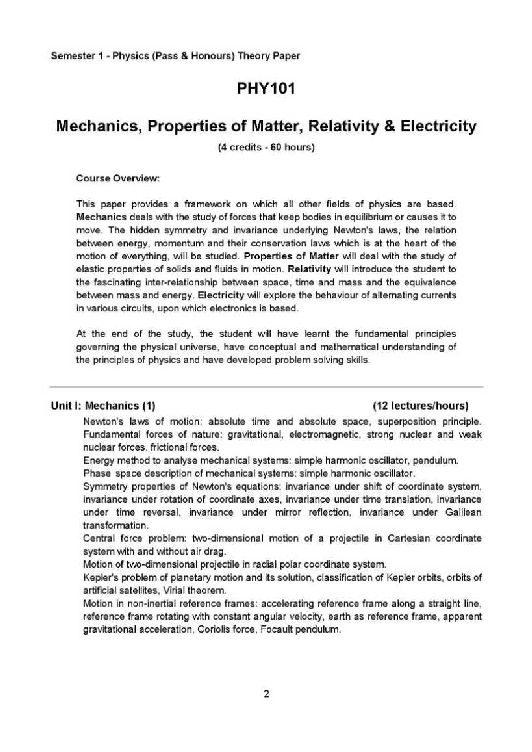 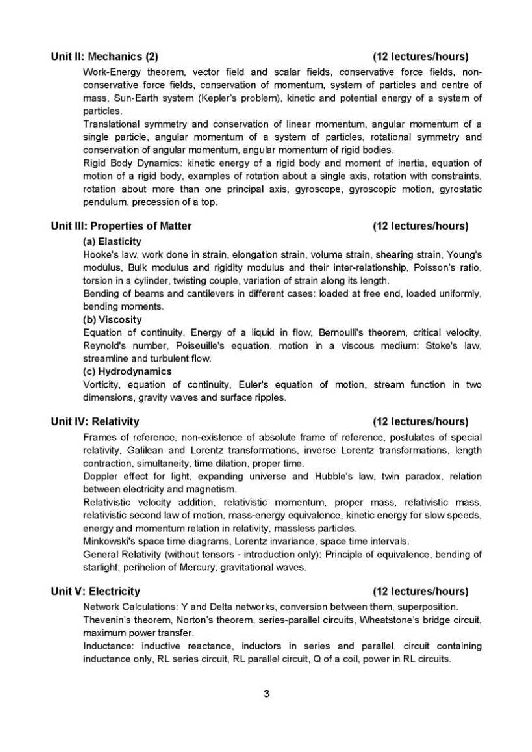 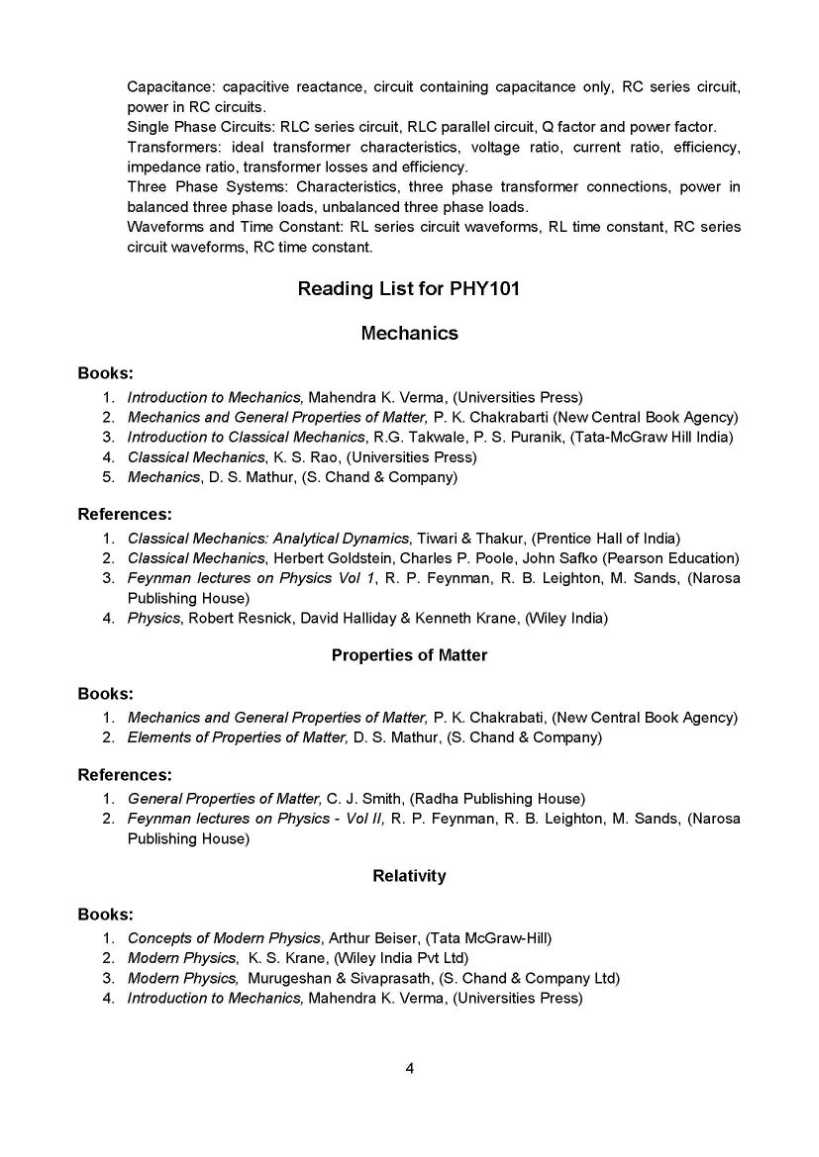 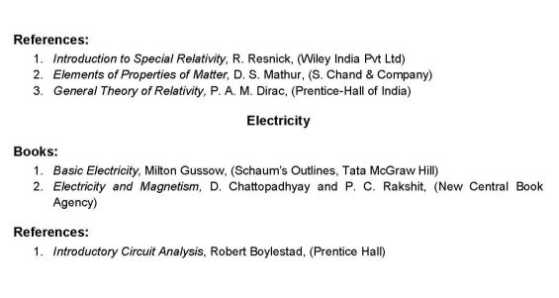 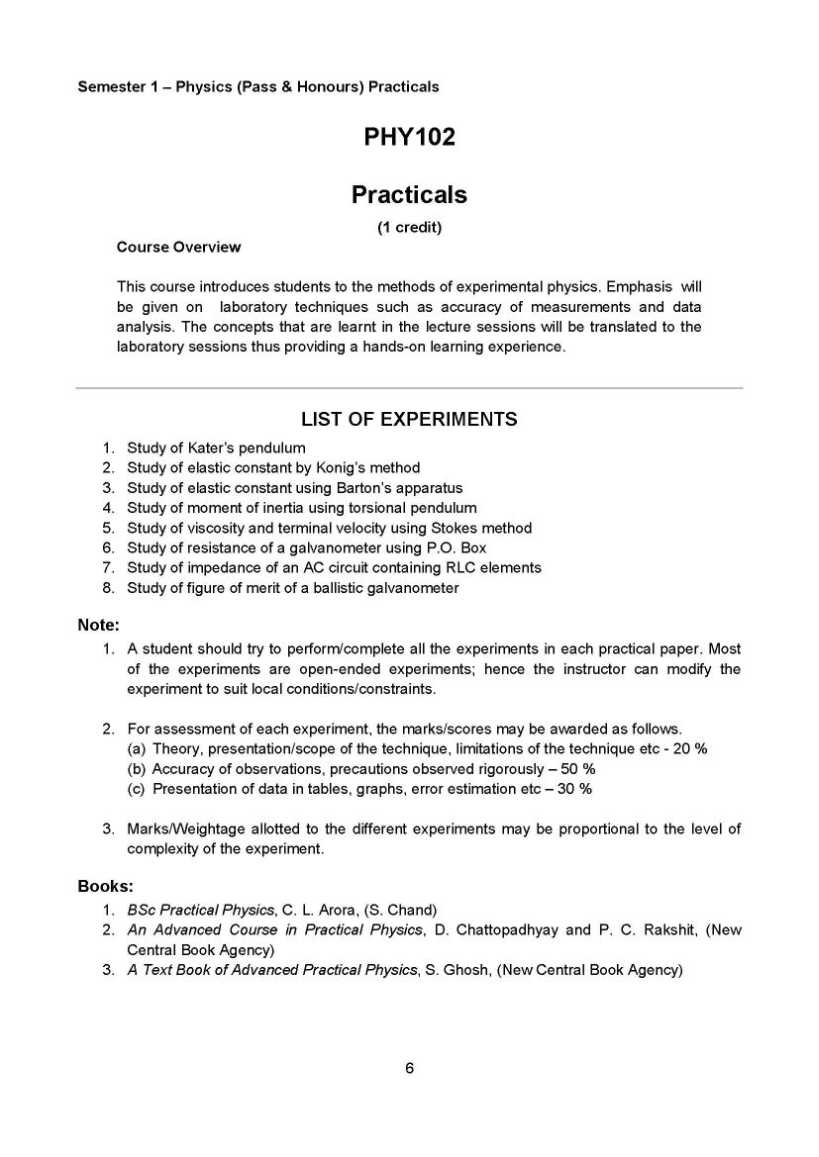 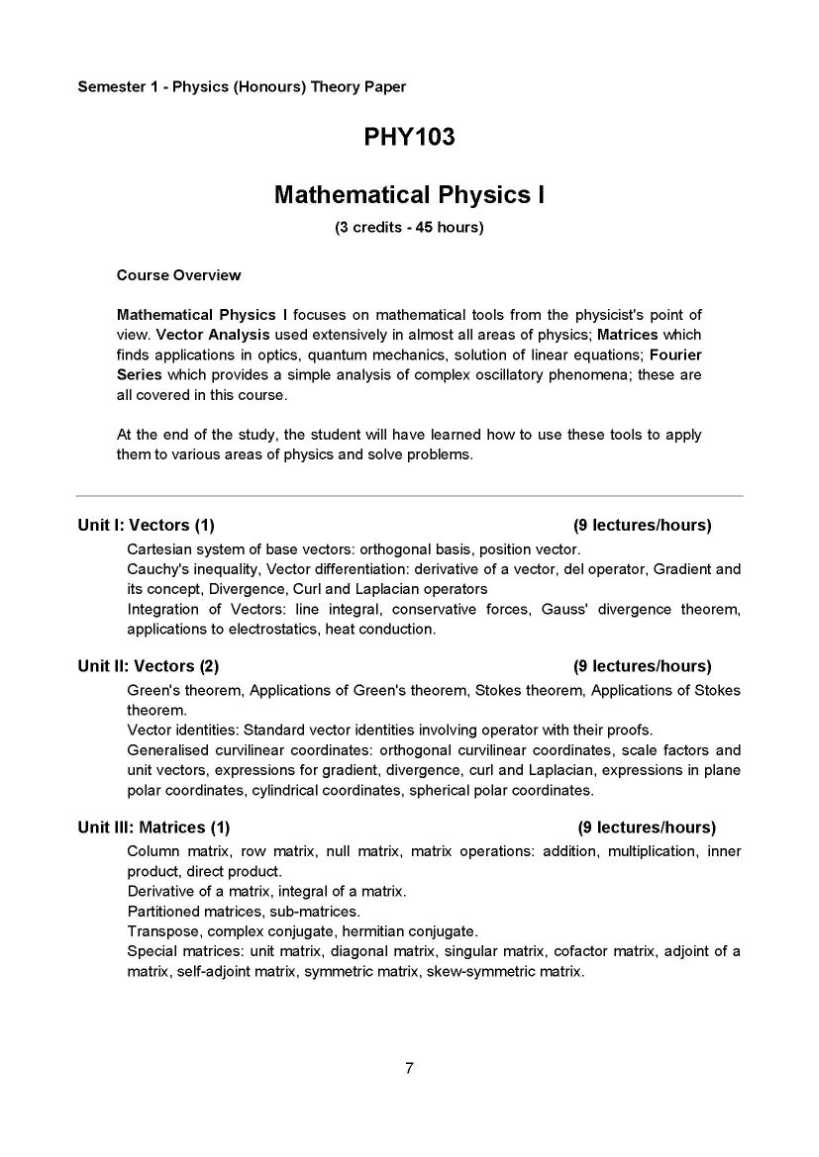 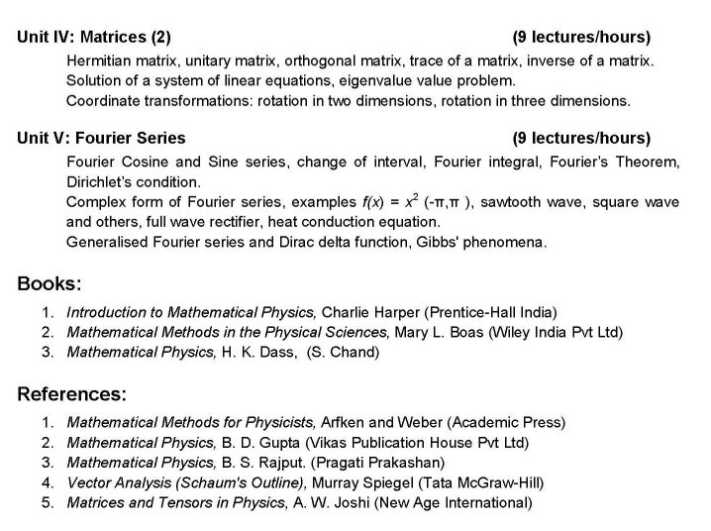 Rest is attached below please have a look on that it is free for you Contact Details Bangalore University Jnana Bharathi, Mysore Rd, Bengaluru, Karnataka 560056 Ph: 080 2321 3172 Map Image 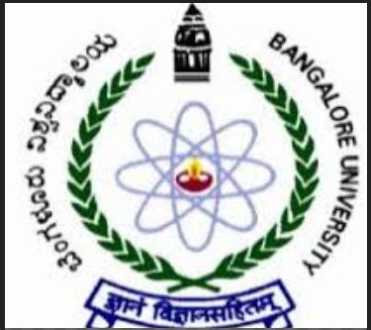
__________________ Answered By StudyChaCha Member Last edited by Nilesh; February 26th, 2014 at 12:47 PM. |